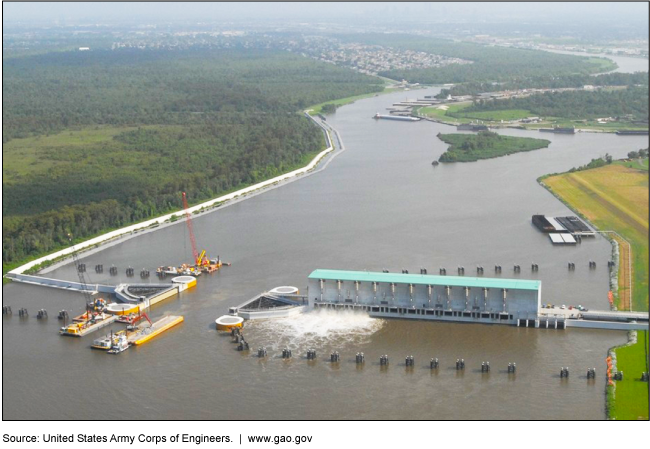Climate Resilience: A Strategic Investment Approach for High-Priority Projects Could Help Target Federal Resources
Fast Facts
There were 14 separate billion-dollar weather and climate disasters in the United States in 2018, with a total cost of at least $91 billion. These costs will likely rise due to climate change.
Investing in climate resilience projects to help communities prepare for hazards such as sea level rise could reduce future costs. The federal government makes ad hoc investments but does not have a strategy for prioritizing projects with the most impact.
We testified that Congress should consider establishing a federal entity to identify and prioritize these projects.
The government’s fiscal exposure from climate change is a topic on our High Risk List.
Infrastructure projects, like this system of levees and other barriers in New Orleans, could reduce risk from coastal storms and flooding—events that could be exacerbated by climate change.

Levees and other barriers being used to control water
Highlights
What GAO Found
The federal government has invested in individual projects that may enhance climate resilience, but it does not have a strategic approach to guide its investments in high-priority climate resilience projects. In GAO’s March 2019 update to its list of federal programs at high risk for fraud, waste, abuse, and mismanagement, or most in need of transformation, GAO reported that one area of government-wide action needed to reduce federal fiscal exposure is in the federal government’s role as the leader of a strategic plan that coordinates federal efforts and informs state, local, and private-sector action. For this 2019 update, GAO assessed the federal government’s progress since 2017 related to climate change strategic planning against five criteria and found that the federal government had not met any of the criteria for removal from the high-risk list. Further, as of August 2019, no action had been taken to implement 14 of GAO’s 17 recommendations to improve federal climate change strategic planning. Additionally, no federal agency, interagency collaborative effort, or other organizational arrangement has been established to implement a strategic approach to climate resilience investment that includes periodically identifying and prioritizing projects. Such an approach could supplement individual agency climate resilience efforts and help target federal resources toward high-priority projects.
Based on its review of prior GAO work, relevant reports, and stakeholder interviews, GAO found six key steps that provide an opportunity for the federal government to strategically identify and prioritize climate resilience projects for investment. These are (1) defining the strategic goals of the climate resilience investment effort and how the effort will be carried out, (2) identifying and assessing high-risk areas for targeted resilience investment, (3) identifying potential project ideas, (4) prioritizing projects, (5) implementing high-priority projects, and (6) monitoring projects and climate risks.
GAO also identified two options—each with strengths and limitations—for focusing federal funding on high-priority climate resilience projects. The options are (1) coordinating funding provided through multiple existing programs with varied purposes and (2) creating a new federal funding source specifically for investment in climate resilience. In addition, GAO identified opportunities to increase the impact of federal funding options on climate resilience, including ensuring adequate and consistent funding and encouraging nonfederal investment in climate resilience.
Why GAO Did This Study
Since 2005, federal funding for disaster assistance has totaled at least $450 billion, including a 2019 supplemental appropriation of $19.1 billion for recent disasters. In 2018 alone, 14 separate billion-dollar weather and climate disaster events occurred across the United States, with total costs of at least $91 billion, including the loss of public and private property, according to the National Oceanic and Atmospheric Administration. Disaster costs likely will increase as certain extreme weather events become more frequent and intense due to climate change, according to the U.S. Global Change Research Program, a global change research coordinating body that spans 13 federal agencies. In 2013, GAO included “Limiting the Federal Government’s Fiscal Exposure by Better Managing Climate Change Risks” on its high-risk list. The cost of recent weather disasters has illustrated the need to plan for climate change risks and invest in climate resilience, which can reduce the need for far more costly steps in the decades to come.
This statement summarizes GAO’s findings from its October 2019 report on climate resilience and federal investment (GAO-20-127). Specifically, it focuses on (1) the extent to which the federal government has a strategic approach for investing in climate resilience projects; (2) key steps that provide an opportunity to strategically prioritize projects for investment; and (3) the strengths and limitations of options for focusing federal funding on these projects.
To perform this work, GAO reviewed about 50 relevant reports and interviewed 35 stakeholders with expertise in climate resilience and related fields, including federal officials, researchers, and consultants. GAO also identified domestic and international examples of governments that invest in climate resilience and related projects.
Recommendations
Congress should consider establishing a federal organizational arrangement to periodically identify and prioritize climate resilience projects for federal investment. Such an arrangement could be designed using the six key steps for prioritizing climate resilience investments and the opportunities to increase the climate resilience impact of federal funding options that GAO identified in its October 2019 report.
